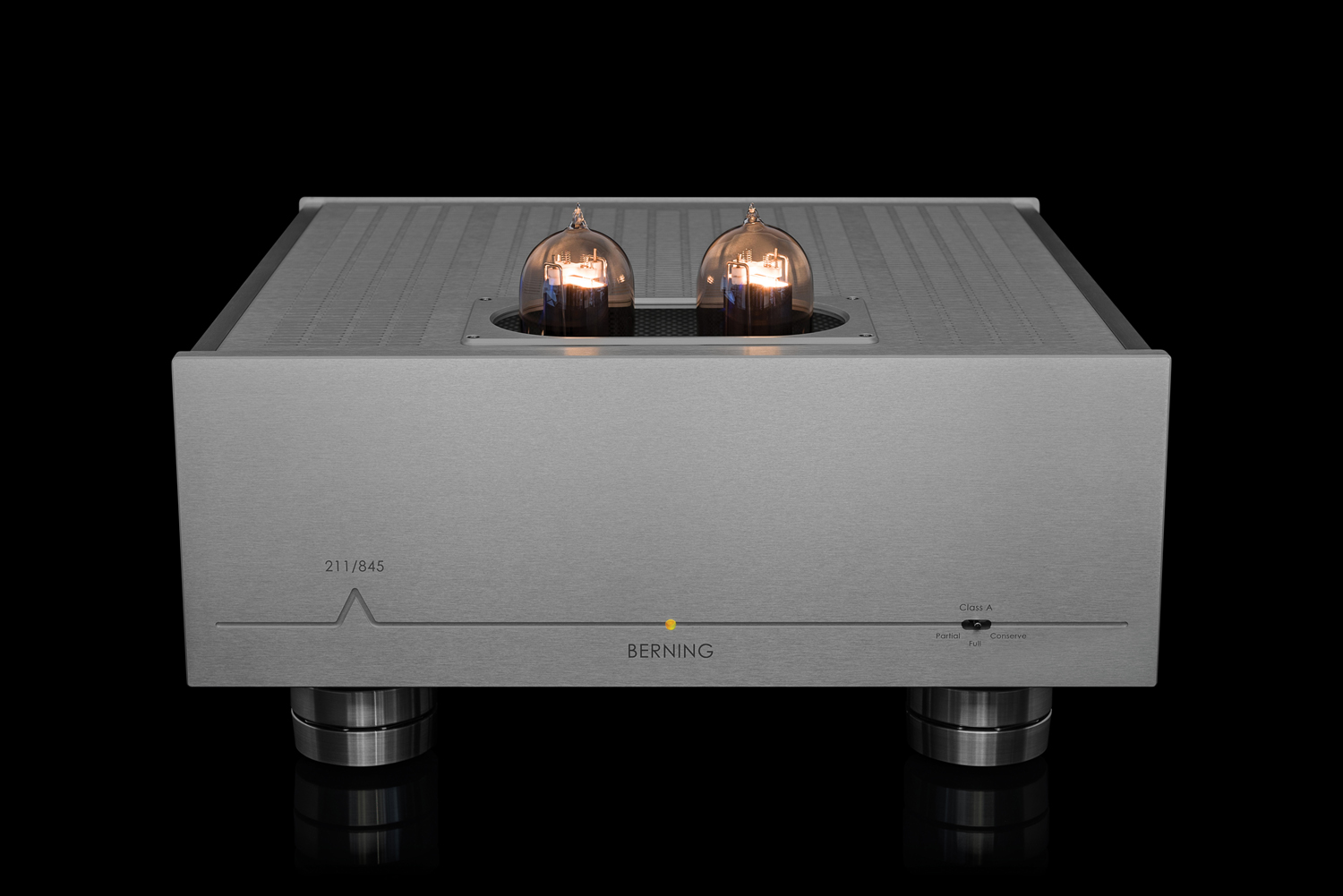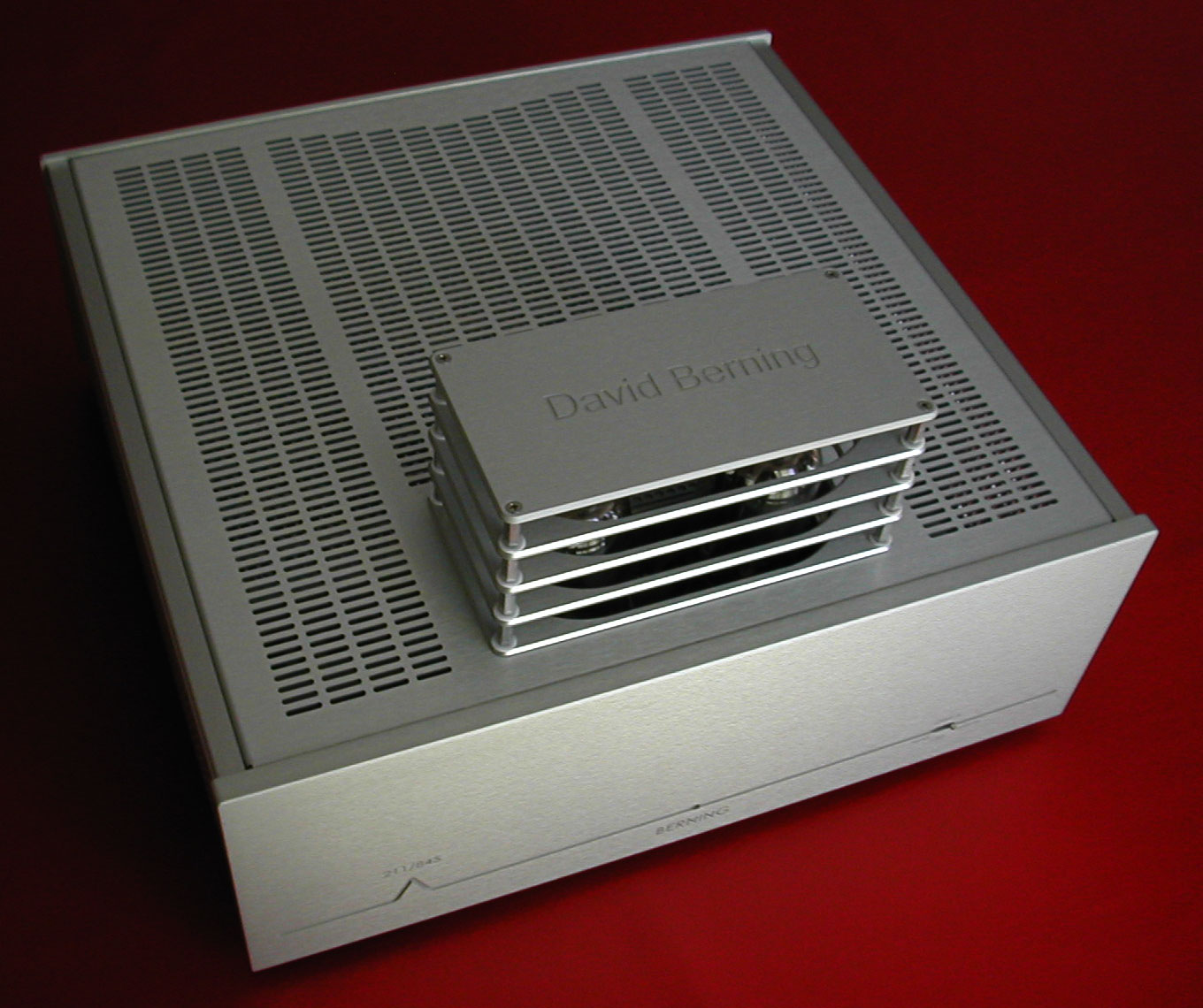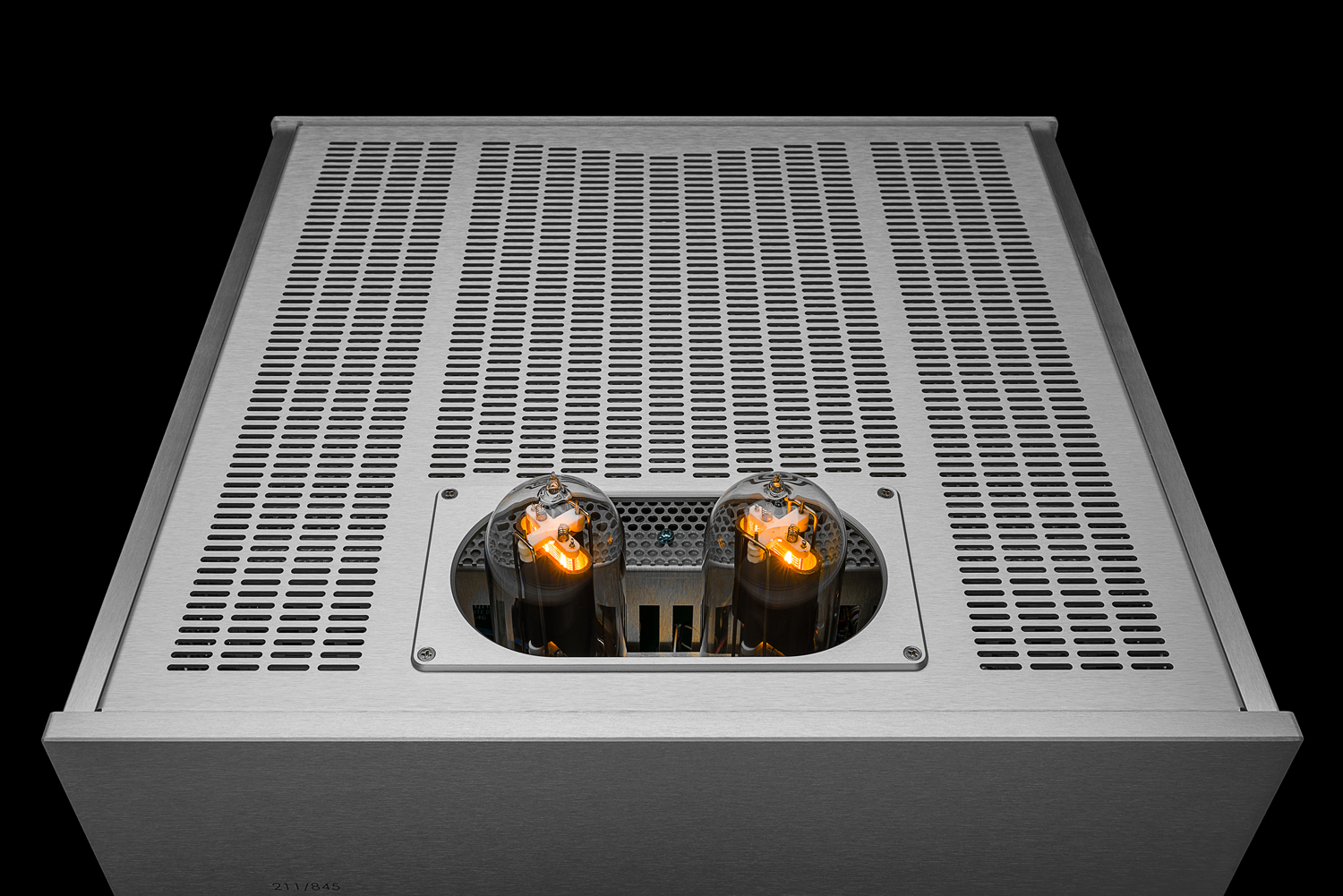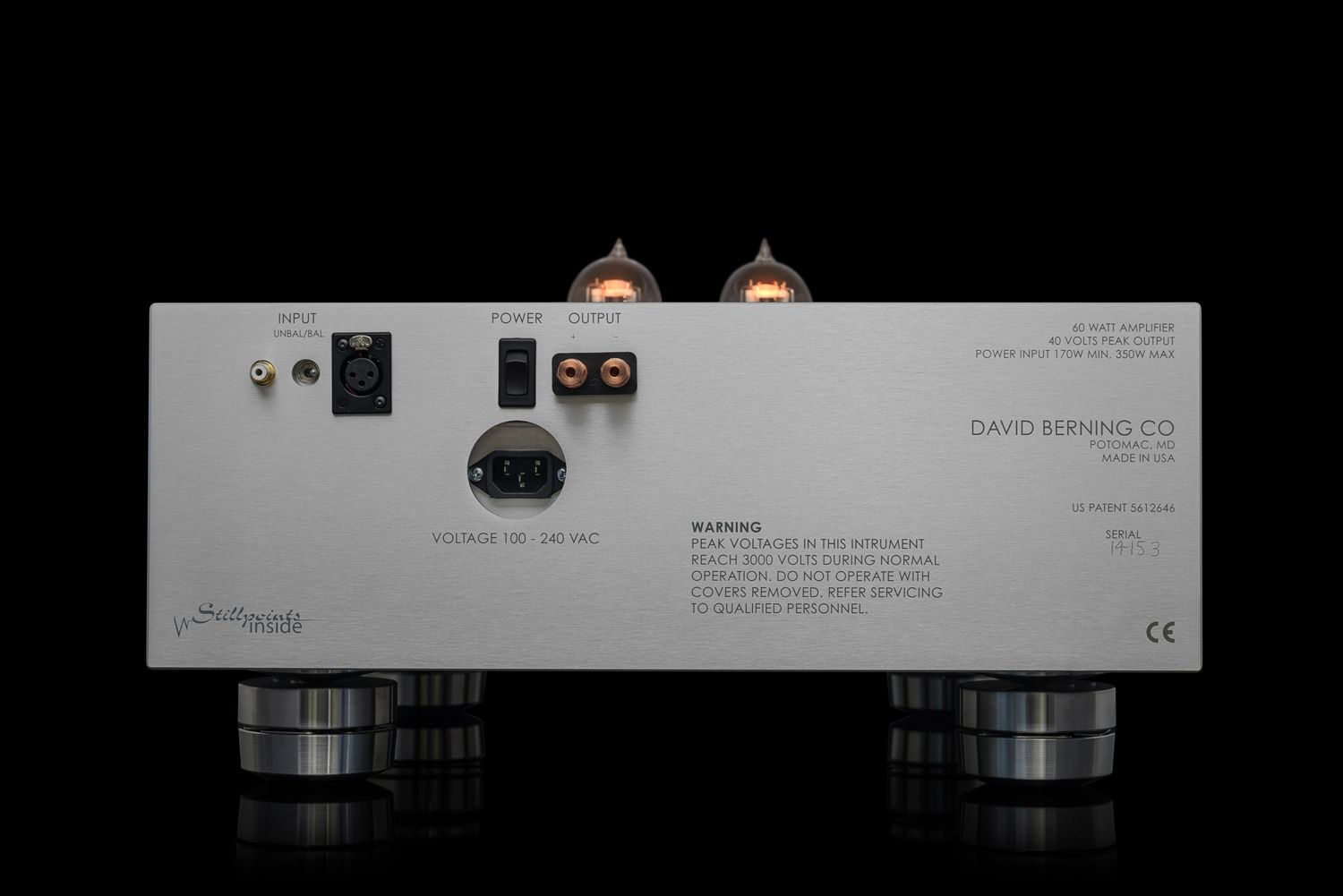The 211/845 amplifiers are Class A, 60 watt monoblock units that feature use of the very linear triodes including the 211 and 845 types. These amplifiers are based on the patented Berning ZOTL output-transformerless technology (US Patent 5,612,646). The 211/845 is designed for loudspeaker loads ranging from 4 Ohms to 16 Ohms, and can be operated without a load. Single-ended RCA type inputs and true balanced XLR inputs are provided. One pair of copper output posts are provided. The 211 type tube has a higher gain than the 845 type tube, and the output impedance of the amplifier is affected by the choice of which tube is used. The amplifiers will autobias to either type.

The 211/845 includes a switch that allows the user to select different amounts of idle current for the output stage. The highest current provides the highest degree of linearity at the highest output power, whereas the lowest current produces the least amount of heat, and can be used for less critical listening. All switch positions operate the amplifiers in Class A. The 211/845 is a no-feedback design, and uses a large transformation ratio to provide good speaker damping using the triodes themselves to provide the damping through the two-way power transfer inherent in the ZOTL. Generally speaking an output transformer can do the same thing, but it is not practical to wind an output transformer with the wide transformation ratios needed to get as low an output impedance that is achieved here. And the bandwidth would not be as good with the transformer.
Like other recent Berning products, the 211/845 incorporates a fully regulated, resonant-type, switching power supply. The regulated switching power-supplies in Berning amplifiers have better control in the bass than tube amplifiers with conventional power supplies. These power supplies allow unusually lightweight and compact amplifiers for their power rating because there is no line-frequency power-transformer. The resonant technology is different than the typical pulse-width-modulation switching power supply in general use. The benefit, a very large number of energy storage capacitors are used for the most effortless sound. The 211/845 also incorporates power factor correction. This greatly reduces line-frequency harmonics injected back into the power line, and gives world-wide plug-and-play operation without the need for mains-voltage setup.
Stillpoints TM Ultra 5 feet are provided as well as standoff mounts inside the amplifier. These products provide a degree of vibration control. The entire audio section is point-to-point hand wired for the finest sound.

211/845 amplifier with included safety cage installed. The safety cage protects the tubes from mechanical damage and also protects users, pets and children from contact with the hot tubes. Use of the safety cage is required in some locations.
Proven ZOTL Technology now in the 211/845
The design of the Berning ZH270 power amplifier represented a radical departure from that of other amplifiers. The ZH270 was the first amplifier using all-tube amplification to properly match the high-voltage, low-current operating parameters of vacuum tubes to the low-voltage, high-current drive requirements of dynamic loudspeakers without using audio-output transformers. The technology is detailed in Berning US patent 5,612,646, and a simplified overview is given below. The ZH270 is respected for its transparency, versatility, and reliability. It enjoyed a production run of over 10 years. The ZH technology has also proven itself in other recent Berning products as well.
Audio-amplifier design engineers have long sought to eliminate the audio-output transformer because of the restrictions that it has always imposed on amplifier performance. Both leakage inductance and interwinding capacitance limit the high-frequency response of the transformer, while core saturation and magnetizing current limit its low-frequency response. Transformer-core hysteresis causes certain kinds of distortion of the non-symmetric and transient waveforms so characteristic of musical reproduction.
Tube Amplifiers have been previously made to drive dynamic loudspeakers without output transformers. These amplifiers are called output-transformerless (OTL) amplifiers. A well-known pioneer of this type of amplifier was Julius Futterman, and there have been many amplifiers made by various companies over the years that are based on the Futterman principles. The basic idea is that given a sufficient number of parallel-connected tubes, enough drive current can be obtained to drive the speaker directly without the impedance-matching transformer.
There are several problems associated with the OTL amplifier that have limited its application. The OTL amplifier is a "brute-force" methodology, and the output impedance of even many of these tubes connected together is nowhere near the speaker impedance. This means that the speaker is starved for current, and the success of mating OTL amplifiers to dynamic speakers is very dependent on the characteristics of individual speakers. Major reliability issues surround OTL amplifiers, not only because a large number of power tubes are required, but also it is necessary that the tubes need to be driven hard to obtain the required output current. Power consumption is high for OTL amplifiers, often exceeding one kilowatt for a stereo pair. Noisy fans may be needed in these amplifiers. Additional room air-conditioning may be needed, further increasing the listening-room noise level.

The Berning ZOTL amplifiers take advantage of new technology in order to eliminate the audio-output transformer. These amplifiers use radio frequency to change the voltage-current transfer characteristics of the output tubes from their normal impedance-plane to one suitable for driving a dynamic loudspeaker. The radio frequency re-mapping is implemented using special high-frequency power conversion techniques. The high-voltage, low-current tube impedance-plane is re-mapped to the high-current speaker impedance-plane through a special transformer at a constant RF carrier frequency of typically 250 kHz. Because the audio signal is riding on a carrier, it is not subject to parasitic elements of the transformer that would otherwise distort the audio signal. There is no low-frequency limit for this impedance conversion, and these amplifiers are dc-coupled, with the exception of a small, high-quality, dc-blocking capacitor at the input of the amplifier to prevent the amplification and application to the speaker of any dc that might be present at the input.
The impedance matching in the ZH amplifier is precisely determined by the effective turns ratio of the RF conversion transformers. Both the push and pull portions of the amplifier are handled in a symmetric fashion, as they are in a conventional transformer-coupled amplifier, and negative feedback is not required to force the positive-output current capability to be similar to the negative-output current capability.
Audio-output transformers have a limited impedance conversion range imposed by the parasitic elements. Audio-output transformers also have limits imposed by voltage breakdown between primary and secondary, and required insulation also affects the parasitic elements adversely. It is difficult to make a high-fidelity transformer with much more than a 25:1 overall primary-to-secondary turns ratio for the above reasons. These restrictions are eliminated in the ZOTL amplifiers, and larger effective overall turns ratios are applied to use the tubes more efficiently than they can be with the smaller ratios. One implication of this change is that the reflected plate resistance of the output tubes is lowered, making the overall output impedance of the amplifier lower without adding additional feedback for this purpose.
Another implication of using a higher-effective turns ratio is that the output tubes operate at lower current and higher voltage than they otherwise would. As tubes become weak with age, the current capability is reduced, but the voltage capability is not affected. Longer useful tube life is expected because less current is required for a given output power. The opposite situation applies to the traditional OTL amplifier.
Audio-output transformer-coupled amplifiers should not be operated without a load connected because the inductance of the transformer's primary can cause the plate voltage to reach a sufficiently high voltage to break down insulating materials, resulting in amplifier failure and even fire. Some amplifiers are even unstable without a load. Unlike output-transformer-coupled amplifiers, the ZOTL amplifiers can be operated safely without a load, as the voltage cannot exceed its normal designed-in operating voltage.

Specifications
- Power consumption: 150 W to 500 W
- Line voltage required: 90-240 VAC, 50-400 Hz.
- Signal to noise: broadband (typical) 50 dB, all Class settings. 20 kHz bandwidth (typical): 86 dB 845 FULL; 90 dB 845 PARTIAL; 92 dB 845 CONSERVE; 83 dB 211 FULL; 86 dB 211 PARTIAL; 86 dB 211 CONSERVE. All figures unweighted.
- Distortion (typical, at 8 ohm loads at 50 W): 0.3% 845 FULL; 0.5% 845 PARTIAL; 1% 845 CONSERVE; 1% 211 FULL; 1.5 % PARTIAL; 1.7% CONSERVE. These may up to double at 4 ohms.
- Typical output power at onset of clipping (3% distortion): 8 ohms 84 W 845; 8 ohms 72 W 211; 4 ohms 110 W 845; 4 ohms 72 W 211. 6V6 driver tubes installed. 6K6 driver tubes result in about 10% less power capability.
- Frequency response at 50 W, 8 ohms: +0, -3 dB 60 kHz all tube combinations, FULL mode. +0, -1 dB 30 kHz all modes and all tube combinations. Frequency response at 50 W, 4 ohms: +0, -3 dB 50 kHz all tube combinations, FULL mode. +0, -1 dB 27 kHz all modes and all tube combinations.
- Full power low-frequency limits: 8 ohms < 1 dB down @ 5 Hz, speaker protection activated @ 4 Hz 50 W; 4 ohms < 1 dB down @ 10 Hz, speaker protection activated @ 8 Hz 50 W, all modes and tube combinations.
- Output impedance (measured at 1 amp, 60 Hz): 1.7 ohms 845 FULL; 2.3 ohms 845 PARTIAL; 3.3 ohms 845 CONSERVE; 2.7 ohms 211 FULL; 3.5 ohms 211 PARTIAL; 5 ohms 211 CONSERVE.
- Single-ended or balanced end-to-end input sensitivity for 50 W: 0.93 VRMS 845 FULL: 0.97 VRMS 845 PARTIAL; 1.0 VRMS 845 CONSERVE; 0.5 VRMS 211 FULL; 0.52 VRMS 211 PARTIAL; 0.56 VRMS 211 CONSERVE. Individual tube gains will affect these numbers, but the trends are valid for all tubes.
- Gain: 26 dB for 845 tubes; 31 dB for 211 tubes.
- Input impedance: 50 k
- Watchdog speaker protection characteristics for tube failure: Initial fast 4A 300ms 6-Ohm speaker 29 Joules plus extended slow 1A 10s 6-Ohm speaker 60 joules. (100 Joules would represent the heating of the bass driver voice coil if a 10-watt RMS signal was applied at low frequency for 10 seconds). Other driver impedances would absorb similar energy.
- Main case size: 48 cm wide, 48 cm deep, 20 cm high, (19 X 19 X 8 inches), including connectors and feet. Output tube cage adds 10 cm (4 inches) to height if used. Tubes extend 5 cm (2 inches) above main case.
- Net weight: 17 kg (36 lb); Boxed, 19 kg (42 lb).
- Finish: silver anodized aluminum
The 211/845 amplifiers are exclusively distributed by:
Hi Fi One
Rick Brown
6978 Corte Langosta
Carlsbad, California 92009
+1 (612) 817-1599
www.rbhifi1.com
Other Features and Specifications
- 211 or 845 output tubes
- Fully automatic biasing for either tube
- 60 Watts Monaural
- Class A Triode
- ZOTL Technology
- Constant output impedance over the entire audio spectrum
- Low noise floor for high-efficiency speakers
- Differentially balanced throughout; single-ended capable inputs
- Zero feedback
- Proprietary switch mode power supplies
- Power Factor Correction for global plug-n-play operation
- No adjustments ever required
- Stillpoint Ultra 5, Ultra Bases, and Circuitboard Isolators are integrated for vibration control. Stillpoint cryogenic treatment is selectively used throughout the amplifier.

Available exclusively via Hi Fi One
